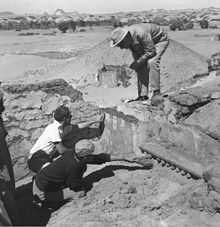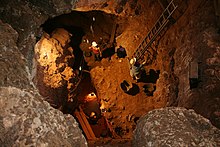
Back حفريات (آثار) Arabic Escavación arqueolóxica AST Arxeoloji qazıntı Azerbaijani Археалагічныя раскопкі Byelorussian Археологически разкопки Bulgarian Excavació arqueològica Catalan Archeologický výzkum Czech Udgravning Danish Ausgrabung German Ανασκαφή (αρχαιολογία) Greek
This article has multiple issues. Please help improve it or discuss these issues on the talk page. (Learn how and when to remove these template messages)
|



In archaeology, excavation is the exposure, processing and recording of archaeological remains.[1] An excavation site or "dig" is the area being studied. These locations range from one to several areas at a time during a project and can be conducted over a few weeks to several years.
Excavation involves the recovery of several types of data from a site. This data includes artifacts (portable objects made or modified by humans), features (non-portable modifications to the site itself such as post molds, burials, and hearths), ecofacts (evidence of human activity through organic remains such as animal bones, pollen, or charcoal), and archaeological context (relationships among the other types of data).[2][3][4][5]
Before excavating, the presence or absence of archaeological remains can often be suggested by, non-intrusive remote sensing, such as ground-penetrating radar.[6] Basic information about the development of the site may be drawn from this work, but to understand finer details of a site, excavation via augering can be used.
During excavation, archaeologists often use stratigraphic excavation to remove phases of the site one layer at a time. This keeps the timeline of the material remains consistent with one another.[7] This is done usually though mechanical means where artifacts can be spot dated and the soil processed through methods such as mechanical sieving or water flotation. Afterwards, digital methods are then used record the excavation process and its results. Ideally, data from the excavation should suffice to reconstruct the site completely in three-dimensional space.
- ^ "What Is Excavation?". Archaeological Excavations in Greece. 13 April 2012. Retrieved 9 July 2020.
- ^ Emery, Katy Meyers (4 October 2011). "Archaeology 101: Artifact versus Feature". MSU Campus Archaeology Program. Retrieved 21 July 2020.
- ^ Ashmore, Wendy; Sharer, Robert (2013). Discovering our past : a brief introduction to archaeology (6th ed.). New York: McGraw-Hill. ISBN 978-0-07-803491-6. OCLC 821067667.
- ^ Kelly&Thomas (2011). Archaeology: down to earth (4th ed.). Belmont, Calif.: Wadsworth, Cengage Learning.
- ^ Sharer, Robert J. (2003). Archaeology: Discovering our past (3rd ed.). Boston: McGraw-Hill Higher Education. pp. 61–63. ISBN 0-7674-2727-0. OCLC 50802481.
- ^ Reeves, D.M. (1936), "Aerial photography and archaeology", American Antiquity, 2 (2): 102–07, doi:10.2307/275881, JSTOR 275881, S2CID 164041261
- ^ Cite error: The named reference
:4was invoked but never defined (see the help page).
© MMXXIII Rich X Search. We shall prevail. All rights reserved. Rich X Search